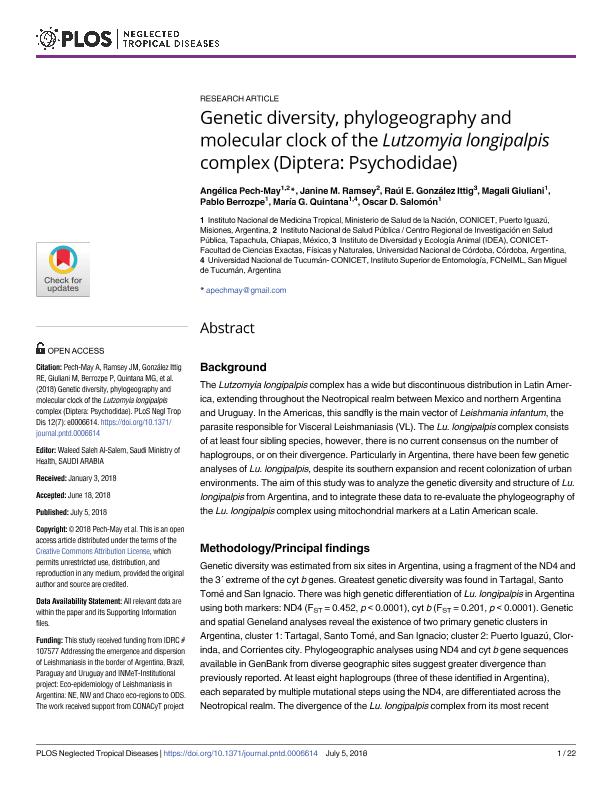Mostrar el registro sencillo del ítem
dc.contributor.author
Pech May, Angélica del Rosario

dc.contributor.author
Ramsey, Janine

dc.contributor.author
González Ittig, Raúl Enrique

dc.contributor.author
Giuliani, Magalí Gabriela

dc.contributor.author
Berrozpe, Pablo Eduardo

dc.contributor.author
Quintana, María Gabriela

dc.contributor.author
Salomón, Oscar Daniel

dc.date.available
2019-10-17T20:20:19Z
dc.date.issued
2018-07
dc.identifier.citation
Pech May, Angélica del Rosario; Ramsey, Janine; González Ittig, Raúl Enrique; Giuliani, Magalí Gabriela; Berrozpe, Pablo Eduardo; et al.; Genetic diversity, phylogeography and molecular clock of the Lutzomyia longipalpis complex (Diptera: Psychodidae); Public Library of Science; Neglected Tropical Diseases; 12; 7; 7-2018; 1-22
dc.identifier.issn
1935-2727
dc.identifier.uri
http://hdl.handle.net/11336/86189
dc.description.abstract
Background: The Lutzomyia longipalpis complex has a wide but discontinuous distribution in Latin America, extending throughout the Neotropical realm between Mexico and northern Argentina and Uruguay. In the Americas, this sandfly is the main vector of Leishmania infantum, the parasite responsible for Visceral Leishmaniasis (VL). The Lu. longipalpis complex consists of at least four sibling species, however, there is no current consensus on the number of haplogroups, or on their divergence. Particularly in Argentina, there have been few genetic analyses of Lu. longipalpis, despite its southern expansion and recent colonization of urban environments. The aim of this study was to analyze the genetic diversity and structure of Lu. longipalpis from Argentina, and to integrate these data to re-evaluate the phylogeography of the Lu. longipalpis complex using mitochondrial markers at a Latin American scale. Methodology/Principal findings: Genetic diversity was estimated from six sites in Argentina, using a fragment of the ND4 and the 3´ extreme of the cyt b genes. Greatest genetic diversity was found in Tartagal, Santo Tomé and San Ignacio. There was high genetic differentiation of Lu. longipalpis in Argentina using both markers: ND4 (FST= 0.452, p < 0.0001), cyt b (FST= 0.201, p < 0.0001). Genetic and spatial Geneland analyses reveal the existence of two primary genetic clusters in Argentina, cluster 1: Tartagal, Santo Tomé, and San Ignacio; cluster 2: Puerto Iguazú, Clorinda, and Corrientes city. Phylogeographic analyses using ND4 and cyt b gene sequences available in GenBank from diverse geographic sites suggest greater divergence than previously reported. At least eight haplogroups (three of these identified in Argentina), each separated by multiple mutational steps using the ND4, are differentiated across the Neotropical realm. The divergence of the Lu. longipalpis complex from its most recent common ancestor (MRCA) was estimated to have occurred 0.70 MYA (95% HPD interval = 0.48–0.99 MYA). Conclusions/Significance: This study provides new evidence supporting two Lu. longipalpis genetic clusters and three of the total eight haplogroups circulating in Argentina. There was a high level of phylogeographic divergence among the eight haplogroups of the Lu. longipalpis complex across the Neotropical realm. These findings suggest the need to analyze vector competence, among other parameters intrinsic to a zoonosis, according to vector haplogroup, and to consider these in the design and surveillance of vector and transmission control strategies.
dc.format
application/pdf
dc.language.iso
eng
dc.publisher
Public Library of Science

dc.rights
info:eu-repo/semantics/openAccess
dc.rights.uri
https://creativecommons.org/licenses/by-nc-sa/2.5/ar/
dc.subject
Lutzomyia Longipalpis
dc.subject
Genetic diversity
dc.subject
Phylogeography
dc.subject
Molecular clock
dc.subject.classification
Bioquímica y Biología Molecular

dc.subject.classification
Ciencias Biológicas

dc.subject.classification
CIENCIAS NATURALES Y EXACTAS

dc.title
Genetic diversity, phylogeography and molecular clock of the Lutzomyia longipalpis complex (Diptera: Psychodidae)
dc.type
info:eu-repo/semantics/article
dc.type
info:ar-repo/semantics/artículo
dc.type
info:eu-repo/semantics/publishedVersion
dc.date.updated
2019-10-16T14:24:36Z
dc.identifier.eissn
1935-2735
dc.journal.volume
12
dc.journal.number
7
dc.journal.pagination
1-22
dc.journal.pais
Estados Unidos

dc.journal.ciudad
Yale
dc.description.fil
Fil: Pech May, Angélica del Rosario. Consejo Nacional de Investigaciones Científicas y Técnicas. Centro Científico Tecnológico Conicet - Nordeste; Argentina. Ministerio de Salud. Instituto Nacional de Medicina Tropical; Argentina
dc.description.fil
Fil: Ramsey, Janine. Instituto Nacional de Salud Pública; México
dc.description.fil
Fil: González Ittig, Raúl Enrique. Consejo Nacional de Investigaciones Científicas y Técnicas. Centro Científico Tecnológico Conicet - Córdoba. Instituto de Diversidad y Ecología Animal. Universidad Nacional de Córdoba. Facultad de Ciencias Exactas Físicas y Naturales. Instituto de Diversidad y Ecología Animal; Argentina
dc.description.fil
Fil: Giuliani, Magalí Gabriela. Ministerio de Salud. Instituto Nacional de Medicina Tropical; Argentina
dc.description.fil
Fil: Berrozpe, Pablo Eduardo. Consejo Nacional de Investigaciones Científicas y Técnicas. Centro Científico Tecnológico Conicet - Nordeste; Argentina. Ministerio de Salud. Instituto Nacional de Medicina Tropical; Argentina
dc.description.fil
Fil: Quintana, María Gabriela. Consejo Nacional de Investigaciones Científicas y Técnicas. Centro Científico Tecnológico Conicet - Nordeste; Argentina. Ministerio de Salud. Instituto Nacional de Medicina Tropical; Argentina
dc.description.fil
Fil: Salomón, Oscar Daniel. Consejo Nacional de Investigaciones Científicas y Técnicas; Argentina. Ministerio de Salud. Instituto Nacional de Medicina Tropical; Argentina
dc.journal.title
Neglected Tropical Diseases

dc.relation.alternativeid
info:eu-repo/semantics/altIdentifier/url/https://journals.plos.org/plosntds/article?id=10.1371/journal.pntd.0006614
dc.relation.alternativeid
info:eu-repo/semantics/altIdentifier/doi/http://dx.doi.org/10.1371/journal.pntd.0006614
Archivos asociados
